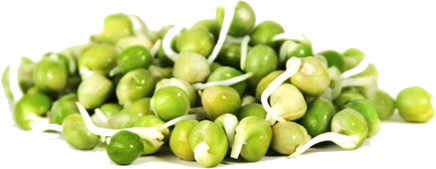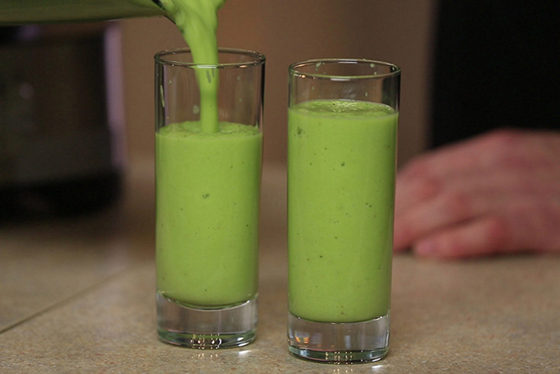Peas are a traditional natural product, the sprouted seeds of which have a surprisingly tender taste resembling fresh green peas: they pair especially well with pasta and rice.
Sprouted peas are easily assimilated by the body (unlike ordinary peas, without causing excessive gas formation).
Microgreens have yellowish-green leaves and light green stems. The taste is slightly sweet, similar to young peas. They are excellent "friends" with fresh vegetables and are used to decorate ready-made dishes. The "tendrils" of pea microgreens look particularly aesthetic. Peas contain fiber, protein, complex carbohydrates, vitamins, and folic acid. It is believed that consuming pea microgreens helps boost immunity, normalize blood sugar levels, and qualitatively affects eye health.
Instructions for use:
Pour the required amount into a bowl of room temperature water and leave for 8-10 hours.
Then place the seeds in a sprouter, covering no more than 25% of the tray, depending on the size of the seeds. Place the sprouts in a bright place at room temperature, changing the water 2-3 times a day.
The sprouts will be ready in about 6-10 days. Cut the sprouts near the seeds and rinse them before eating. They can be stored in the refrigerator for up to a week (8-10 days).

* Pea seeds have a high germination rate and contain vitamins B, E, C, K, PP, amino acids, fiber, saturated fatty acids and various minerals. Young pea sprouts are easily digestible and do not cause flatulence, unlike fruits.
Pea microgreens are a valuable source of protein substances containing such useful amino acids as cystine, lysine, arginine, tryptophan, methionine. In addition, it is rich in fiber and contains many vitamins B1, B2, C and minerals, including zinc, phosphorus, manganese, iron, potassium, calcium, copper and magnesium. At the initial stage of development, pea sprouts contain the greatest number of useful substances, including vitamins, amino acids and micro- and macroelements. In fact, the amount of useful substances in pea microgreens is tens of times higher than their content in ripe peas. The protein and fiber contained in it help suppress hunger centers in the brain and cause a feeling of satiety, which can be used for weight loss. Also, the proteins contained in peas can replace almost all essential amino acids that are usually found in animal food. Rich in vitamin C, peas strengthen the body's immune system by stimulating the proliferation of immune system cells and improving the recognition of foreign agents for their destruction.
The content of vitamin C, flavonoids, carotenoids and other biologically active substances in microgreens helps to normalize blood cholesterol levels. It also has antitumor activity due to the presence of many antioxidants that fight inflammation in the body and prevent the occurrence of malignant neoplasms. The fiber contained in it is necessary for the nutrition of beneficial microorganisms and helps to normalize the microflora.
You should not eat pea microgreens if you have:
• a tendency to allergies;
• kidney and urinary tract diseases in the acute stage;
• diabetes;
• exacerbation of gastrointestinal diseases.
For growing microgreens, the best choice would be pea seeds. However, you should not exclude forage peas, which are also a more affordable option and sometimes even show better germination than seed peas.
It is important to remove the halves of broken peas, as they rarely germinate and can become a source of mold (however, there are cases when even halves of peas germinate).
It is necessary to pay attention to the presence of holes in the peas, as sometimes bugs can start there that gnaw through the pea.
To soak the peas, you need to do several rinses to clean the water. The water should be at least +18 ° C. It is important to remove all debris that floats. After this, the peas need to be filled with water twice as much by volume and add 3% hydrogen peroxide, which will kill all pathogenic flora.
To saturate the water with oxygen, place an aeration stone in a container with peas and turn on the compressor. After 6 hours of soaking, the peas need to be removed from the water and left in a sieve for 3-8 hours to dry and become saturated with air. After this, you can start planting.
To grow pea microgreens without soil, you can use various materials as a substrate, for example, coconut fiber, agrowool, napkins, fabric, vermiculite, gauze and others. However, if you choose to grow without a substrate, you need to carefully monitor the moisture content of the pea roots so that they do not dry out.
If you decide to grow peas, for example, on jute strips, you first need to soak the jute mat with water, and then place it on the bottom of the container where the microgreens will grow.
To grow pea microgreens, you need to pour 90-100 g of soaked peas into one box, evenly distributing them in one layer inside the box.
The boxes with the sown peas should be placed in a dark, cool place. On the 3rd-4th day, when the stem grows higher than 1 cm, you can expose the sprouts to the light. Pea microgreens are not so demanding of light, but if your lighting consists of cold spectrum lamps of 6500 K and an illuminated area of 30-40 watts per m2, then the peas will be grateful to you.
To water the sprouts, you need to use bottom watering with water. Peas are a plant that requires abundant watering, so you need to ensure that the substrate and roots do not dry out. However, it is also important not to overwater the plant.
Detox smoothie with pea microgreens.
A drink that will leave no one indifferent. It will help accelerate metabolism in the body and give vigor for the whole day.
Ingredients:
pea microgreens - 100 g;
rolled oats – 2 tbsp;
peeled kiwi — 2 pcs;
orange juice (preferably fresh) – 200 g;
honey - 1 tsp.
Preparation method:
Put all ingredients into a blender bowl and blend until smooth. After that, the smoothie can be drunk immediately. It can be stored in the refrigerator for no more than 4-6 hours in a closed container at a temperature of +2 to +10 °C.













